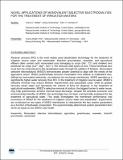Notice
This is not the latest version of this item. The latest version can be found at:https://dspace.mit.edu/handle/1721.1/141385.2
NOVEL APPLICATIONS OF MONOVALENT SELECTIVE ELECTRODIALYSIS FOR THE TREATMENT OF IRRIGATION WATERS
| dc.date.accessioned | 2022-03-29T15:17:46Z | |
| dc.date.available | 2022-03-29T15:17:46Z | |
| dc.date.issued | 2021 | |
| dc.identifier.uri | https://hdl.handle.net/1721.1/141385 | |
| dc.description.abstract | Reverse osmosis (RO) is the most widely used desalination technology for the treatment of irrigation source water and wastewater. Brackish groundwater, seawater, and agricultural effluent often contain both monovalent ions damaging to crops (Na+, Cl−) and divalent ions beneficial for crops (Ca2+, Mg2+, SO42−). RO removes both types of ions. These beneficial ions must then be reintroduced to the desalinated water through the addition of fertilizer. Monovalent selective electrodialysis (MSED) demonstrates greater potential to align with the needs of the agriculture sector. MSED preferentially removes monovalent ions relative to multivalent ions, defined as monovalent selectivity, via selective ion-exchange membranes. MSED operates at a significantly higher water recovery than RO. In the treatment of irrigation source water, MSED’s selective removal may reduce fertilizer requirements and associated costs, while its greater recovery saves water and decreases the volume of brine for disposal. In the treatment of agricultural wastewater, MSED’s selective removal of sodium, the biggest barrier to water reuse, may help greenhouses achieve minimal liquid discharge. Despite the possible economic and environmental benefits of MSED, the technology has not been commercially employed for the treatment of agricultural water. This study investigates the membrane performance and economics of MSED for the treatment of irrigation source water and wastewater. Experiments are conducted on two types of MSED membranes to characterize the key system parameters as a function of feedwater composition. The experimentally-determined system parameters then serve as inputs to our MSED cost model. | en_US |
| dc.relation.isversionof | https://idadesal.org/ | en_US |
| dc.rights | Creative Commons Attribution-Noncommercial-Share Alike | en_US |
| dc.rights.uri | http://creativecommons.org/licenses/by-nc-sa/4.0/ | en_US |
| dc.source | Prof. Lienhard | en_US |
| dc.title | NOVEL APPLICATIONS OF MONOVALENT SELECTIVE ELECTRODIALYSIS FOR THE TREATMENT OF IRRIGATION WATERS | en_US |
| dc.type | Article | en_US |
| dc.identifier.citation | Y.D. Ahdab, G. Schücking, and J.H. Lienhard, “NOVEL APPLICATIONS OF MONOVALENT SELECTIVE ELECTRODIALYSIS FOR THE TREATMENT OF IRRIGATION WATERS,” IDA International Water Reuse & Recycling Conference, Rome, Italy, 11–14 October 2021 | en_US |
| dc.relation.journal | IDA International Water Reuse & Recycling Conference | en_US |
| dc.eprint.version | Author's final manuscript | en_US |
| dc.type.uri | http://purl.org/eprint/type/ConferencePaper | en_US |
| eprint.status | http://purl.org/eprint/status/NonPeerReviewed | en_US |
| dspace.date.submission | 2022-03-29T12:44:54Z | |
| mit.license | OPEN_ACCESS_POLICY | |
| mit.metadata.status | Authority Work and Publication Information Needed | en_US |
